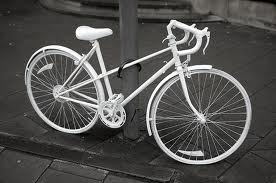Bike Lanes VS. Car Lanes in New York City
Anthony Allocca
Cars and Bicycles are the main means of transportation for people living in and around New York City. Department of Transportation's goal is to accelerate the growth of safe cycling by quickly providing a backbone system of bicycle routes that connect all five boroughs. In the beginning of the summer in 2009, the Department of Transportation (DOT), completed the city's goal of building two hundred bike lane miles in New York in just three years. Also expansion and innovation of the overall network, including the installation of 4.9 miles of bike paths physically separated from car traffic lanes, twenty sheltered bike parking structures and three thousand one hundred bike racks. The Department of Transportation remains committed to its goal of doubling bicycle commuting between now and 2015.
The bicycle boom of the late nineteenth Century had a strong impact on New York area, and the City of Brooklyn was especially responsive, providing accommodation in Eastern Parkway, Ocean Parkway, and elsewhere. Several of the middle twentieth century parkway projects of Robert Moses included bike paths. When more people could afford cars, bicycling declined and the bikeways decreased. Robert Moses, who we have learned about in class, is responsible for the state wide improvement of parks and highways. Robert Moses was behind the creation of Jones Beach, Montauk State Park, The Triborough and Verrazano-Narrows Bridges. New bridges connecting Queens to the Bronx, or Brooklyn to Staten Island, did not provide for bicycles or pedestrians. In the past decade, bicycling resurged, bike lanes on major bridges were created, refurbished, and improved. In a few of our classes we eve seen many bicyclists on the bike paths when we walked over the Brooklyn Bridge and during our long walk through Central Park.
A bicycle is considered a vehicle in the state of New York even though there is no license required to ride a bicycle. Delivery bikes are commonly used in New York for fast food deliveries and Pedi cabs, offering travel over short distances, including guided tours of Central Park. Bicyclists follow traffic regulations, for example move in the direction of traffic, must use hand signals, not ride on the sidewalks and must use lights at night. Bicyclists can have their headphones on but only in one ear. Most cycling is in the same lanes as motor traffic, since most streets provide no separate facilities for bicycle. In the beginning of 2009, about one hundred and seventy miles of painted lanes are simply marked with paint, and lie between a parking lane and a traffic lane. This is a problem because they are often blocked by trucks unloading and by double parked cars.
The problem with most bike lanes are that they are in the door zone and cyclists must be cautious for motorists and passengers unaware of the law forbidding opening a door into a traffic lane in a way to interfere with traffic, including bicycles. This could result in injuries, broken bones, and sometimes death. Approximately twenty cyclists are killed most years, usually by collision with a moving vehicle. The location where a cyclist has been killed will be marked by a white painted Ghost Bike. Apart from being a memorial, it usually intended as reminder to passing motorists to share the road.
 |
| Ghost Bike |
The cause and antagonism between cyclists and motorists is due to them is guided arrangement of the bike lanes. Cyclists ride in between flowing traffic and parked cars, this forces a fight for space and safety. There would not be an issue if the bike lanes were closer to sidewalk. New York is one of the City’s in the United States that is using this method so no one is injured. The Department of Transportation have done what they were intended to do, get cyclists off the road and onto bike lanes. The number of New Yorkers who ride a bike daily to either get to work or exercise has risen thirteen percent in the past year. The population of New York City is expected to reach nine million by 2030, and transporting all those people in the current bus and subway systems is impossible.
The City Department of Transportation presented a traffic study showing that both car crashes and sidewalk cycling have decreased since the bike lane redesign. The study also showed that cyclists are now much less likely to ride on the sidewalk after the redesign, a decrease of up to eighty four percent. Motorists are also less likely to speed inside the redesigned area than outside it. These new types of bicycle facilities include Bike Boxes to advance waiting areas for bicyclists at intersections in front of the stop line for cars. Green bike lanes are adjacent to the sidewalk.
While the debate rages on between motorists and cyclists over the safety and utility of new bike lanes in Manhattan and Brooklyn, statistics show that cycling related fatalities and overall pedestrian injuries have fallen in recent years, even as the cyclist on the streets of New York have grown. There will always be those who resist change, but in this case of bike lanes VS. car lanes, the community boards have strongly supported them.
September 5,2009.
2) Adler, Ben, “The Rise of Urban Biking”, The Nation, October 17, 2011. http://www.thenation.com/article/163671/rise-urban-biking3) Lafsky, Melissa, “The NYC Bike Lane Battle: A Metaphor for U.S. Transportation”, The Infrastructurist. http://www.infrastructurist.com/2011/03/21/the-nyc-bike-lane-battle-a-metaphor-for-us-transportation/.